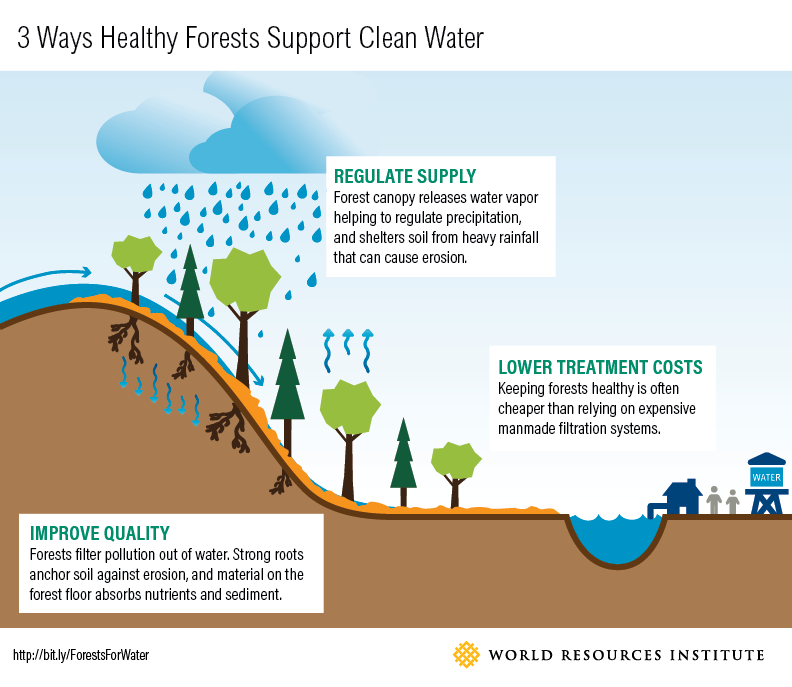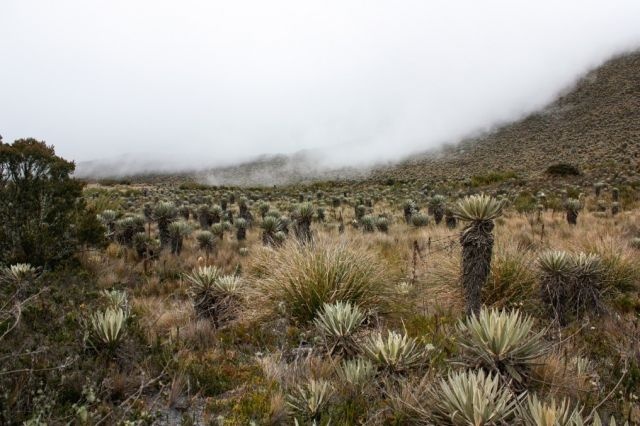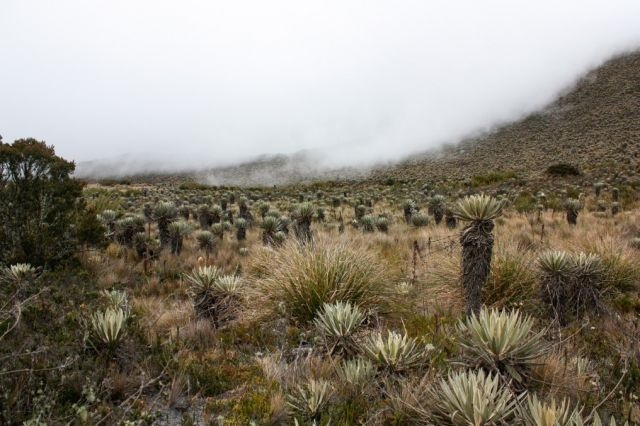This article was originally published on WRI Insights.
An old Colombian saying goes: “en abril, lluvias mil,” meaning “it rains a lot in April.” But that was not the case this year.
This April, precipitation levels in Colombia were 40% less than expected, well below the historical average. Rainfall was down throughout the country, but shortages were particularly noticeable in the Caribbean and Andean regions. To add complication, meteorological and environmental agencies observed more volatile rainfall regimes in recent decades. This makes it hard to predict when dry or wet periods will begin or end, which is already difficult for tropical countries like Colombia that quickly change from wet to dry seasons.
The Colombian Congress became attuned to the threat of water scarcity in mid-May when policymakers received a worrying message from the Minister of Mines and Energy: Low water levels threatened the production of hydroelectric power, which provides 73% of the country’s electricity. According to regional environmental authorities, some strategic reservoirs were only about a third full.
This came at a time when health officials around the globe are encouraging citizens to use water generously for handwashing and sanitation to curb the spread of COVID-19. This sanitary precaution could further reduce the amount of water available for energy production in some parts of Colombia.
Colombian authorities asked citizens to voluntarily reduce their water use and discussed levying an energy tax on citizens. The move would put more pressure on citizens’ economic stability at a time when the country is already experiencing its single-worst spike in unemployment.
But there is a better way: Instead of solely using fiscal strategies that target short-term relief, the government can use nature-based solutions to complement ongoing efforts aimed at creating more sustainable water and energy systems over the long term.
Confronting Colombia’s Water Woes
As climate change worsens, situations where decision-makers face difficult choices for meeting environmental and socio-economic objectives will likely become more complex. According to a 2018 report for policymakers from the IPCC, current rates of warming will likely destabilize weather patterns, including rainfall. As a result, there are limits to using past hydrological patterns in Colombia when assessing future trends.
This new reality could reduce hydropower generation by 10% in the next three decades, threatening water access for farmers and people in cities. In addition, changes in rainfall patterns could lead to higher fossil fuel use to compensate for lower hydropower generation. This would translate to increasing greenhouse gas emissions, which would then cause further changes in precipitation patterns.
Healthy forests in upland watersheds are essential to maintaining stable hydrology and delivering reliable electricity. However, the gradual deforestation of the Andes may further prevent natural landscapes from influencing dry and wet periods. Between 2002 and 2019, Colombia lost over 4.3 million hectares of forest cover. Moreover, the unusually high number of deforestation alerts reported in 2020 — in spite of the government’s aggressive effort to curb primary forest loss — continue to raise concerns over water scarcity.
The Potential of Nature-Based Solutions
Despite the precariousness of this situation, the damage is reversible. Nature-based solutions use natural systems to protect and benefit human populations through improving water security, managing disaster risks and building resilience to climate change, among other benefits. These strategies often involve protecting, restoring, sustainably managing and creating ecosystems such as forests, grasslands or wetlands. Nature-based solutions can complement and enhance existing development plans, as well as extend the menu of water-management options available to resource managers and policymakers.
In particular, efforts to conserve forest cover and restore degraded lands, as advocated by the country-led, pan-Latin American Initiative 20x20, can provide cost-effective, nature-based alternatives to “gray” infrastructure like dams and levees.
In Colombia, a founding member of that initiative, protecting and restoring high-mountain natural forest ecosystems like páramos (alpine tundra) and cloud forests can strengthen the country’s water and energy resilience. These ecosystems are vital for regulating water flows, reducing sedimentation and contributing to water yields in watersheds. They have spongy soils that absorb, retain and gradually release rainwater over time. Additionally, they have the highest water yield compared to other land uses — such as plantations of pine and eucalyptus trees — in the high elevation Andes.
Studies show that watersheds supported by páramos and cloud forests provide water to 70% of the Colombian population. These watersheds are the backbone of local rural livelihoods; hydroelectricity generators that are important for the nation’s energy matrix; and habitats that hold highly vulnerable endemic species. Many of these páramos and forests also have important spiritual value for local communities — some are even considered the sacred origin of humanity itself.

3 Steps to Prepare Colombia to Invest in Nature
Despite the value these forests bring, nature-based solutions involving forests are not yet implemented. Authorities in Colombia — and other countries in similar situations — can invest in a three-tier strategy for deploying nature-based solutions that strengthen the country’s water and energy resilience.
1. Develop an Evidence-based Business Case
Colombian authorities should support research to develop an evidence-based business case for nature-based solutions. A better understanding of the potential environmental, social and economic benefits that stem from combatting deforestation in vulnerable ecosystems would help resolve an important bottleneck keeping governments and private investors from financing nature-based solutions. The business case should clearly identify the potential revenue streams, the distribution of revenues and an anticipated return on investment for decision-makers and potential investors.
WRI can help fill this knowledge gap through its partnerships with governments, other NGOs and scientists. In Colombia, for example, WRI is supporting the Cloud Forest Blue Energy Mechanism, an effort led by Conservation International and The Nature Conservancy to apply nature-based solutions in the Andes and meet water and energy goals.
In other countries, WRI is leading economic analyses to advise public utilities agencies on managing their watersheds to reduce wildfire risk, protect utility infrastructure and enhance water and electric security. In some cases, this type of rigorous and grounded inter-disciplinary research was instrumental in achieving innovative management actions. For instance, in the North Yuba watershed in the Tahoe National Forests, WRI’s collaborative research lead to an unanimous decision from the board members of the Yuba Water Agency to support the first Forest Resilience Bond pilot — an initiative to reduce fire risk in the watershed through targeted forest restoration activities.
2. Develop participatory monitoring and project evaluation
Having participatory monitoring and project evaluation ensures investors that programs are effective, while allowing communities to engage in the process and share their knowledge. Also, if effectively integrated into local institutions and stakeholder groups, this can ensure that projects continue over the long term. This is key for nature-based solutions, given how long it takes to manage and restore ecosystems.
This type of approach was recently used in Peru during a locally-led research project. Community members used novel techniques with dye-tracer experiments to measure the contributions of ancient, nature-based knowledge. They found that 1,400-year-old pre-Inca technology could boost water security in the face of climate change, which can be used to benefit local communities today.
Similar grassroots ideas were implemented in other high-mountain regions like Nepal, where researchers integrated rainfall monitoring activities into local secondary school curriculums. This participatory model for gathering data is giving local farmers a new way to understand local water needs and help them make better irrigation decisions.
3. Develop policy support
Nature-based projects and programs are most likely to be systematically implemented and reach scale when policy supports them.
Enhancing water availability and quality is often a key objective of landscape restoration and deforestation efforts. These priorities are reflected in Colombia’s National Restoration Plan and National Development Plan, a constitutionally mandated four-year program. Through those policies, Colombia committed to revitalizing 1.4 million hectares through ecological restoration, agroforestry systems and sustainable forest management.
In September, President Duque announced that the country would grow 180 million trees across 300,000 hectares by 2022. Through its political participation in Initiative 20x20, Colombia can also leverage funding from private impact investors to support its national commitments.
Other opportunities for policy change exist. For example, it is imperative that Colombian government entities ensure energy supplies to the national market during periods of drought (such as during El Niño). Regulatory entities in the energy market could recognize nature-based solutions as drought insurance measures or portfolio diversification strategies. This recognition could facilitate hydropower companies’ access to government compensation and public resources available for drought prevention.
Local and regional policies can also help. Cali, Colombia uses a “payment for ecosystem services” model to invest in the protection of the upstream forests and páramos that safeguard their water supplies. Cali, Medellín and Bogotá are all members of the Cities4Forests initiative, which provides support for cities seeking to develop similar policies and plans for ecosystem protection.
A Critical Moment For Investing in Nature-Based Solutions
We are living through times of rapid and unpredictable change. These times require long-term thinking, out-of-the-box decision-making and strong leadership. As countries worldwide continue to face increased water demands to address public health issues, it is critical to explore every sustainable solution possible. For nations that rely on hydropower, this includes making sure that water flow goes undisrupted. Nature-based solutions can address water scarcity while providing long-term benefits — not just for Colombia, but for nations worldwide.
Colombia’s water and energy sectors are dynamic and open to change. There is a real opportunity to devise strategies that continue to strengthen the performance of the energy and water sectors while contributing to the country’s overall agenda of sustainability and social inclusion. Investing in Colombia’s forests and paramos and following a strategy that is innovative, evidence-driven, participatory and inclusive can give resource managers, policymakers and investors a real chance to enrich Colombians’ lives.

